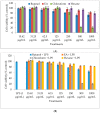Anti-Inflammatory Potential of Ethyl Acetate Fraction of Moringa oleifera in Downregulating the NF-κB Signaling Pathway in Lipopolysaccharide-Stimulated Macrophages
- PMID: 27809259
- PMCID: PMC6273666
- DOI: 10.3390/molecules21111452
Anti-Inflammatory Potential of Ethyl Acetate Fraction of Moringa oleifera in Downregulating the NF-κB Signaling Pathway in Lipopolysaccharide-Stimulated Macrophages
Abstract
In the present investigation, we prepared four different solvent fractions (chloroform, hexane, butanol, and ethyl acetate) of Moringa oleifera extract to evaluate its anti-inflammatory potential and cellular mechanism of action in lipopolysaccharide (LPS)-induced RAW264.7 cells. Cell cytotoxicity assay suggested that the solvent fractions were not cytotoxic to macrophages at concentrations up to 200 µg/mL. The ethyl acetate fraction suppressed LPS-induced production of nitric oxide and proinflammatory cytokines in macrophages in a concentration-dependent manner and was more effective than the other fractions. Immunoblot observations revealed that the ethyl acetate fraction effectively inhibited the expression of inflammatory mediators including cyclooxygenase-2, inducible nitric oxide synthase, and nuclear factor (NF)-κB p65 through suppression of the NF-κB signaling pathway. Furthermore, it upregulated the expression of the inhibitor of κB (IκBα) and blocked the nuclear translocation of NF-κB. These findings indicated that the ethyl acetate fraction of M. oleifera exhibited potent anti-inflammatory activity in LPS-stimulated macrophages via suppression of the NF-κB signaling pathway.
Keywords: IκBα; RAW264.7 cells; inflammation; inflammatory mediators; proinflammatory cytokines.
Conflict of interest statement
The authors declare that there are no conflicts of interest.
Figures







Similar articles
-
Moringa oleifera Flower Extract Suppresses the Activation of Inflammatory Mediators in Lipopolysaccharide-Stimulated RAW 264.7 Macrophages via NF-κB Pathway.Mediators Inflamm. 2015;2015:720171. doi: 10.1155/2015/720171. Epub 2015 Nov 2. Mediators Inflamm. 2015. PMID: 26609199 Free PMC article.
-
Ethyl acetate fraction of Terminalia bellirica (Gaertn.) Roxb. fruits inhibits proinflammatory mediators via down regulating nuclear factor-κB in LPS stimulated Raw 264.7 cells.Biomed Pharmacother. 2017 Nov;95:1654-1660. doi: 10.1016/j.biopha.2017.09.080. Epub 2017 Oct 6. Biomed Pharmacother. 2017. PMID: 28954384
-
Inhibition of LPS-induced inflammatory biomarkers by ethyl acetate fraction of Patrinia scabiosaefolia through suppression of NF-κB activation in RAW 264.7 cells.Immunopharmacol Immunotoxicol. 2012 Apr;34(2):282-91. doi: 10.3109/08923973.2011.602412. Epub 2011 Aug 19. Immunopharmacol Immunotoxicol. 2012. PMID: 21854107
-
The Anti-inflammatory Effect of Gnaphalium affine Through Inhibition of NF-κB and MAPK in Lipopolysaccharide-Stimulated RAW264.7 Cells and Analysis of Its Phytochemical Components.Cell Biochem Biophys. 2016 Sep;74(3):407-17. doi: 10.1007/s12013-016-0744-7. Epub 2016 Jun 21. Cell Biochem Biophys. 2016. PMID: 27324043
-
Bioactive Compounds in Moringa oleifera Lam. Leaves Inhibit the Pro-Inflammatory Mediators in Lipopolysaccharide-Induced Human Monocyte-Derived Macrophages.Molecules. 2020 Jan 2;25(1):191. doi: 10.3390/molecules25010191. Molecules. 2020. PMID: 31906558 Free PMC article.
Cited by
-
Moringa oleifera seeds mitigate myocardial injury and prevent ventricular failure induced by myocardial infarction.Am J Transl Res. 2020 Aug 15;12(8):4511-4521. eCollection 2020. Am J Transl Res. 2020. PMID: 32913524 Free PMC article.
-
Unveiling the multifaceted antiproliferative efficacy of Cichorium endivia root extract by dual modulation of apoptotic and inflammatory genes, inducing cell cycle arrest, and targeting COX-2.RSC Adv. 2024 Jun 17;14(27):19400-19427. doi: 10.1039/d4ra02131b. eCollection 2024 Jun 12. RSC Adv. 2024. PMID: 38887636 Free PMC article.
-
Recent advances in cell membrane-camouflaged nanoparticles for inflammation therapy.Drug Deliv. 2021 Dec;28(1):1109-1119. doi: 10.1080/10717544.2021.1934188. Drug Deliv. 2021. PMID: 34121563 Free PMC article. Review.
-
Three Constituents of Moringa oleifera Seeds Regulate Expression of Th17-Relevant Cytokines and Ameliorate TPA-Induced Psoriasis-Like Skin Lesions in Mice.Molecules. 2018 Dec 10;23(12):3256. doi: 10.3390/molecules23123256. Molecules. 2018. PMID: 30544700 Free PMC article.
-
Effects of Moringa oleifera Lam. Supplementation on Inflammatory and Cardiometabolic Markers in Subjects with Prediabetes.Nutrients. 2022 May 5;14(9):1937. doi: 10.3390/nu14091937. Nutrients. 2022. PMID: 35565903 Free PMC article. Clinical Trial.
References
-
- Ueda F., Iizuka K., Tago K., Narukawa Y., Kiuchi F., Kasahara T., Tamura H., Funakoshi-Tago M. Nepetaefuran and leonotinin isolated from leonotis nepetaefolia R. Br. Potently inhibit the LPS signaling pathway by suppressing the transactivation of NF-κB. Int. Immunopharmacol. 2015;28:967–976. doi: 10.1016/j.intimp.2015.08.015. - DOI - PubMed
-
- Vo V.A., Lee J.-W., Shin S.-Y., Kwon J.-H., Lee H.J., Kim S.-S., Kwon Y.-S., Chun W. Methyl p-hydroxycinnamate suppresses lipopolysaccharide-induced inflammatory responses through akt phosphorylation in RAW264.7 cells. Biomol. Ther. 2014;22:10–16. doi: 10.4062/biomolther.2013.095. - DOI - PMC - PubMed
MeSH terms
Substances
LinkOut - more resources
Full Text Sources
Other Literature Sources
Research Materials

